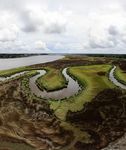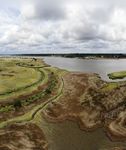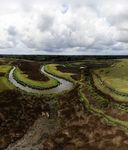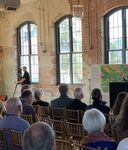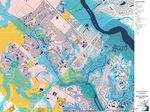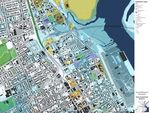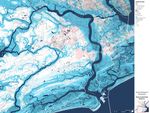Dutch Dialogues Charleston - Colloquium Summary & Direction July 2019
←
→
Page content transcription
If your browser does not render page correctly, please read the page content below
Dutch Dialogues Charleston ®
On May 1-2, 2019, the City of Charleston and the Historic Charleston Foundation hosted a Colloquium,
the first public part of the Dutch Dialogues Charleston process. This document contains the
Colloquium summary, key takeaways to guide the Dutch Dialogues Workshop in July 2019, and links to
the Colloquium presentations.
For Dutch Dialogues history click here, and for up-to-date Dutch Dialogues Charleston information visit dutchdialoguescharleston.org.
Acknowledgements
The Dutch Dialogues rely on the extensive collaboration of Charleston Water System, the American Flood Coalition,
numerous experts, internationally, domestically and locally. the Medical University of South Carolina, and the Nature
Outside voices can challenge norms and suggest new Conservancy, coupled with the team from Waggonner &
opportunities to think differently about water, but ultimately Ball, The Water Institute of the Gulf, the Kingdom of the
the local eye is always required to connect ideas and ground Netherlands and the many technical partners supporting
them in place. For Dutch Dialogues Charleston, there are those organizations, was essential. This includes the
many leaders, funders, participants and advocates to thank significant investment made by the Clemson Design
for their contributions. The list is long and likely would be Center in Charleston in hosting the event and engaging the
incomplete if itemized. Many hands are required to do this students who will lead our resilient futures.
work.
Thank you all so very much. This work would not happen
The collaboration in leadership and funding from the without such strong collaboration.
Historic Charleston Foundation, The City of Charleston, The
Dutch Dialogues Charleston ® 2
Grounded in Science, Driven by DesignPlenary Setting: Opening, Stage-setting, and Connected efforts
Dr. B.D. Wortham-Galvin, Director of the Resilient Design indeed “the Lowcountry,” with half of all home elevations
program and the Clemson Design Center, Winslow Hastie, at less than 10ft above sea level. Like many coastal
Director of the Historic Charleston Foundation, Mayor John environments, Charleston’s physical, environmental and
Tecklenburg of the City of Charleston and Dale Morris aesthetic riches are the sources of its most pronounced
of The Water Institute of the Gulf opened by anchoring vulnerabilities. Urbanization-induced landfill has changed
Charleston’s challenges to the work of the Colloquium. the water-land interface but the region’s marshes still want
to act like marshes, regardless of use. Extreme weather
They noted that while the Netherlands has hundreds events and nuisance, sunny-day flooding are equally
of years of managing water, its most recent strategies costly and demand equal attention: both impact property,
move away from “fighting the water” and towards “Living livelihoods, critical infrastructure, economic activity and
with Water.” Smart spatial planning drives investment to property values. These impacts are worrisome to citizens,
facilitate adaptation to storm impacts and climate change policymakers, emergency responders and investors alike.
while also providing other societal benefits. This Living with
Water approach is a mindset of adaptation and efficient
investment that Charleston needs.
Golden Rules from the Netherlands
The Dutch Dialogues are a search for solutions, direction,
and a shared, common vernacular to drive policy, action and Change Attitudes. Embrace water and its spatial quality. It
proactive investment. Pre-event preparation and prevention demands and is a tool for inclusiveness.
are always less costly -- in terms of human life, impacts and
dollars spent -- than post-event emergency response and Cooperate. “God created the world, but the Dutch created
recovery. the Netherlands.” Living safely with water is a collective
responsibility and needs collective solutions.
David Waggonner of Waggonner and Ball, Dr. Norm Levine
of the College of Charleston and Steven Slabbers of Bosch- Have a Larger Perspective, in time, scale, purpose, systems
Slabbers Landscape Architecture then set the stage for and the environment.
the effort. They explained work in the City of New Orleans,
Bridgeport, CT and Hampton Roads, VA, research on sea Don’t Accept Solutions that Only Work. Single-purpose
level, seismic and heat in the Lowcountry, and the history solutions fail the test of time. They are expensive to build,
of water management and spatial adaptation in the maintain and lose public support over time. Instead, seek
Netherlands. They assessed the challenging Lowcountry solutions for water challenges that add other values –
landform in the context of increasing storms, sea-level rise economic, environmental, recreation, mobility and social. A
and aspirational pathways for solutions. design-based approach identifies these other values and
their salience to the communities that form a city. Dare to
Every physical landscape, its inhabitation, systems, and think outside of the box, create a vision beyond narrowly-
uses, is unique. Discovering the context of the place, and bound programming or funding constraints. Have a vision:
how to create or fortify identity through water, is key. This from inspiration comes funding, and from funding comes
mindset presumes a relationship with and respect for water. inspiration.
Ignoring or constantly fighting the water, “walling it out,” will
not be an effective or affordable long-term strategy. Have courage to think big and the guts to act small. A
compelling long-term vision must be shared and understood,
Charleston’s natural and physical systems and landforms but small projects must be quickly implemented to prove to
are grounded in dunes and islands, and are shaped by citizen’s that the vision is achievable.
waves, winds, currents and interconnected, inland water
systems (creeks, rivers, marshes, estuaries). This is - Steven Slabbers, Bosch Slabbers Landscape Architects
Dutch Dialogues and Living With Water are registered trademarks of Waggonner & Ball
Photo Credit Left and Continued on the Covers: Ramiro Diaz
3Ongoing Efforts In a recent survey, 3/4 of local
businesses report considerable
Mark Wilbert, Chief Resilience Officer of the City of impacts from storms and flooding and
Charleston, Ken Dierks of Kimley Horn in collaboration
with Nemac/Fernleaf, Wes Wilson of the US Army Corps 44% reported loss of income. This is
Engineers, Matt Fountain of the City of Charleston
Stormwater Management Team and Jacob Lindsey,
economically unsustainable.
Planning Director for the City of Charleston, provided
overviews of a much larger and diverse set of flood-risk
Ongoing Flood Risk Mitigation Efforts
mitigation and adaptation efforts in the City.
Dan Burger of Charleston Resilience Network, Rick Devoe of City of Charleston Flooding and Sea Level Rise Strategy: The
SC Sea Grant, Liz Fly of The Nature Conservancy, Ian Scott City’s 2019 updated Flooding and Sea-level Rise Strategy
of the Metro Chamber of Commerce and Lauren Gellatly plans for 2-3 feet of sea-level rise over the next 50 years, and
of Lowcountry Local First wrapped-up the Colloquium’s has five distinct focal areas: governance, resources, land use,
Plenary. outreach and infrastructure. An online, active platform keeps
residents informed and engaged.
Patience and urgency, plus a long-term vision and funding,
are necessary to manage Charleston’s multi-generational City of Charleston Vulnerability Assessment: The Vulnerability
and multifaceted challenges of growth, flooding, Assessment analyzes the many regional threats and their
transportation, equity and cultural heritage. Scales of interactions with populations and assets to highlight the most
time, geography, elevation, occupation and science must critical areas. If Charleston does not understand and manage
underpin solutions. Coastal cities recognize that state and well its many vulnerabilities, investment and people can and
federal governments are unable to effectively respond to will go elsewhere.
local climate change impacts. Natural systems, which can
City of Charleston USACE 3x3 Study: The US Army Corps
address many of these impacts, should be embraced.
3 x 3 Peninsula Flood Risk Management study is focused
upon surge and storm risks on the peninsula and will explore
While the Cooper River and the Peninsula work tends
structural and non-structural solutions to mitigate those risks.
toward the retrofitting of existing built environments, West
These responses shall be aligned with other investments in
Ashley and Johns Island developments are frequently
the lower (battery-areas) and mid-peninsula areas and could
planned in previously undeveloped areas. Given this, there
incorporate locally-preferred alternatives.
is a clear, yet shrinking, possibility to “get it right” from the
start.
City of Charleston Stormwater Management Program: The
newly-created Stormwater Management Department is led
Businesses note that their largest challenges are the ability
by a newly-appointed Stormwater Program Manager who
to attract and retain talent and provide affordable housing will update the 1984 Master Drainage Plan. The Department
to the growing workforce. Talent attraction and affordable is a one-stop shop for the City’s stormwater management
housing are intertwined with stormwater and tidal flooding programs, projects, resources and capabilities.
and the growing threat of sea-level rise. In a recent survey,
3/4 of local businesses report considerable impacts from Related Planning Efforts: The City’s Planning Department
storms and flooding and 44% reported loss of income. This is focused upon future flood risks but also housing,
is economically unsustainable. transportation, tourism, the changing economy across the
City’s neighborhoods. These and other issues are part of
Business sees political fragmentation as a challenge, the the ongoing Comprehensive Plan Update. The Planning
lack of vision as worrisome, and the desire for more regional Department noted that inspiration from the Netherlands is
cooperation and a single voice (“water ombudsman”) to essential but that Charleston is 17-times less dense than the
focus attention, resources and information as a neccesity. Netherlands with a tax-base that reflects a more suburban,
less urban environment.
Dutch Dialogues Charleston ® 4
Grounded in Science, Driven by DesignFocal Areas
Lockwood Corridor/Medical District is a critical provider of essential services, and is currently impaired by recurrent tidal and
storm-related flooding.
New Market and Vardell’s Creek Area is experiencing significant growth and requires comprehensive land use and water planning
to address the low elevation, stormwater flooding, unmet housing needs, and broader neighborhood development patterns.
Johns Island requires a set of best water management practices to mitigate current and predicted flood risk. This multi-
jurisdictional area with many infrastructure and growth-related challenges demands a regional perspective.
Church Creek is heavily urbanized, underutilized, and constrained and serves primarily as a drainage conduit and cause of flooding.
Settlement patterns, geography, land use, water storage, and discharge needs, and upland opportunities will influence proposed
interventions to lower flood risk and enhance post-event resiliency while ensuring the vitality and viability of the area.
Focal Areas were introduced by Jacob Lindsay, City of Charleston Planning Director along with Jared Bramblett of Davis & Floyd,
Bob Horner of Weston & Sampson, and Christopher Morgan of the City of Charleston.
526
Church Creek &
West Ashley Park
26
Newmarket &
Vardell’s Creek
Lockwood Corridor/
Medical District
Johns Island
1 mi
1 km
5Key Takeaways: Lockwood Corridor and Medical District
Operations Vulnerability repaving and reducing congestion, would begin to explore
Participants noted that access to health services, patient how road improvements could be rethought to reduce
and personnel safety, and overall well-being are at risk. flood risk mitigation / enhance resilience. Similarly, several
Many patients had trouble accessing the medical district, expressed a desire to (re)engineer parking enhancements
including Emergency Rooms, because of flooding. Current with stormwater storage and a desire to create more transit
flooding will impact where patients seek future medical opportunities (bus and water taxis) to alleviate congestion
care, and recent announcements of providers “moving and improve access.
upland” confirm this.
Shared Parking
Largest Employer There was significant discussion about how shared parking
The District is the single largest area of concentrated across the three hospital systems might free-up space
employment in South Carolina. Thus, the District’s for greater stormwater storage. Incentives and citizen
aggregate economy -- patients, families, medical facility engagement to collect and store rainwater, “adopt a drain,”
personnel, suppliers and supporting businesses -- is at “rainproof” their neighborhoods, become an “evacuteer,”
extreme risk. Many hope / expect that the Vulnerability create and manage a nearby “living shoreline” are desired.
Analysis will quantify this economic risk. The State is Similarly, the nearby Charleston Public Housing Authority,
refining its shelter-in-place strategy and hospitals await the Citadel, West Edge, Riley Ballpark, local businesses
new guidelines to understand operational impact, since and surrounding counties must be part of the collaborative
emergency responders lack facilities in the District. effort.
Ecological Vulnerability Connectivity Improvements
Participants expressed concern about the former landfills Expanding the District’s limited connections to key centers
surrounding and underneath the District and water quality – The Citadel, College of Charleston, Brittlebank Park,
(in WestEdge and at Laurel Island). Similar discussions Westedge, Riley Field – offer new opportunities.
on the water quality in Ashley River and Long Lake raised
additional concern. Habitat loss, tree cover loss and their Communication Campaign
relation to tourism and human comfort brought forward Participants identified the need for greater resilience
greater considerations. awareness in the city including structured partnerships to
enable others to understand their risks.
Energy Vulnerability
There is deep concern about the redundancy and reliability Investments and Policy
of the District’s energy supply and hope a district energy There is interest in perimeter protection along the Ashley
strategy could increase resilience. River, which will be addressed by the USACE 3x3 study (and
which would likely require additional pumping capacity).
Heat Vulnerability The area’s existing density and intense use may preclude
Beyond the work on slowing, storing, redirecting and large-scale use of green infrastructure.
adapting to water, complementary solutions would help as
many solutions for water also reduce urban heat. Further Opportunities
Some wanted to explore storm water storage opportunities
Collaboration Intent in / near Alberta Long Lake combined with enhanced
Participants expressed a desire to collaborate more deeply, recreation; others were encouraged by plans-in-
combine (and increase) local funding and programs where development to elevate key pedestrian corridors between
possible, better leverage state (transportation) funding, and medical facilities and elevate key utilities at the same time.
gain more control over key transportation arteries in (and Still others referenced the Charleston Plan and the need
near) the District. to further coordinate with its directions. There is a desire
to require a “resilience component” in any future permitted
Transportation Planning project to create and deepen a culture of resilience
Many hoped that SCDOT, in addition to its primary task of awareness and responsibility.
Dutch Dialogues Charleston ® 6
Grounded in Science, Driven by DesignAbove: Medical District and Lockwood Corridor Floodplains and Sea Level Rise map
Top Left and Right: Team collaborations to understand the work area
7Key Takeaways: New Market and Vardell’s Creeks
Complex and Compact of redevelopment, amenities the residents need and want,
Two old creeks – one covered, one not -- define its physical and neighborhood identities to safeguard. This begs for
boundaries and the area is low and flat. One-third of the more community outreach, engagement by the City, and a
adjacent Eastside neighborhood have public housing. community trust-building effort.
“High-ground” in the area is close to the Cooper River
(Morrison Drive and East Bay Street), along Huger Street Transit and Connectivity
and, on the west-side, abutting the Lowline. There is The Morrison / East Bay corridor and the Meeting Street
a considerable amount of mixed-use and market-rate corridor provide opportunities to reinforce transit nodes
housing development on the Zone’s western edge (Meeting (bike, bus, future BRT) in / near the zone. Participants
Street), some of which extends into the Cooper Bridge wondered whether a water taxi (linking to lower peninsula,
Redevelopment Zone. Cultural amenities in the zone include or even to Lockwood Corridor or Mt. Pleasant) would be
churches, schools, the community center, Martin’s Park and possible and if / how the future Lowline redevelopment can
green space amongst some of the public housing. also create an east-west corridor linking to Hampton Park,
Medical District and the Riley Ballpark.
Wet, Flat and Vulnerable
There are four distinct, interrelated water challenges in the Stewardship and Governance
Cooper River Redevelopment District and in the nearby There is a need to (re)create a water identify in the
Eastside community: stormwater impacts, compromised neighborhoods and provide outreach and resources to
drainage, high-water (tidal and surge) inundation, and the enable residents to help manage and have stewardship of
future sea-level rise impacts upon drainage and possible stormwater (e.g., adopt a drain, rain barrels, rain gardens,
inundation. Understanding and managing these water risks infiltration space). The complex answers to who owns the
must be primary for all (current and future) neighborhood streets and who is responsible for what on those streets
development as well as the communication to residents and confuse residents and make street and stormwater
business of these risks. The drainage system is not well- management unnecessarily complex.
understood and shallow groundwater levels are likely high.
Lee Street and Nearby
An obvious, if possibly overlooked, opportunity is to
repurpose Lee Street and nearby surface parking lots for
water storage as leases there are nearing deadline.
Green infrastructure (bioswales etc.) and an immediate
opportunity to recreate the blue-green links that previously
defined the area is important. Participants are curious if
the Port’s Columbus Terminal might play a role in perimeter
protection, and others wondered whether any peninsula
perimeter protection stemming from the USACE 3x3 study
will require a pumping system. Many want to explore using
the lower Newmarket Creek watershed (under I-26 and
Ravenel Bridge) for additional neighborhood water storage
and, possibly, a community amenity (park).
Redevelopment and Equity
Parts of the Cooper River Redevelopment District are
hotbeds of (re)development that are influencing the
neighborhood’s identity. Participants believe that
respecting and reinforcing the community’s identity as (re)
development occurs are important. There is uncertainty
– within the neighborhood and without -- about the target Open space and networks sketch made during the Colloquium
Dutch Dialogues Charleston ® 8
Grounded in Science, Driven by DesignAbove: Cooper River Bridge Redevelopment District, New Market and Vardell’s Creek Floodplains and Sea Level Rise
Top Left, Center and Right: Site tour view, team collaborations and white board diagram of study area watersheds
9Key Takeaways: Johns Island
Ecological Identity and Vulnerability flood-proofing technologies and low-impact development
Johns Island is the 4th largest island on the US east coast. pilots. Citizens ask: “How do we get this right?” Successful
Its strengths are its aesthetic beauty, coastal ecology, resilient development will occur only if and when it is
mid-island elevation, its treescape, marshes and sandy grounded in the Island’s current and future geology,
soils, and the large tracts of undeveloped land that create a geography and hydrology. Citizens wisely question whether
distinct, bucolic, languid sense of place. The strengths are to call “Johns Island affordable if people are buying homes
vulnerable and diminishing. The island’s large farms are with excessive flood risk?” And they wonder whether
also diminishing as is the land stewardship that farmers successful development practices piloted in the Lowcountry
frequently practice. Development pressure and the Urban could enable developers and leaders in Charleston to share
Growth Boundary have a tense relationship when it comes their efforts with other communities facing similar threats.
to flood risk, as newer development within the Boundary is If done right, “resilience” is a brand to further showcase
occurring in low-lying areas. Charleston.
Flood vulnerability
The island is reliant upon historic and poorly-maintained
overland drainage infrastructure, development-specific
(not system- or- island-wide) drainage plans, insufficient or
poorly-enforced stormwater regulations and management
practices. The Island’s explosive development,
development-related stormwater impacts (e.g., raising
homesites without understanding impacts on nearby
communities and drainage system limits), traffic, storm
evacuation challenges, and complex relationships between
the City and developers adds to the existing flood risk.
Sea-level rise and higher mean water levels in the Ashley,
Stono and Wadmalaw Rivers and Bohicket Creek will further
constrain overland drainage.
Cultural Vulnerabilities
The island’s cultural assets – including the Gullah-Geechee
community, slave descendants, and its Civil War, Civil Rights
movement and native American histories – are rich and
distinct. All are threatened by land development, recurrent
tidal and stormwater flooding and sea-level rise. There is
much to protect and much to lose.
Transportation Planning
Almost every discussion about Johns Island is influenced
by transportation and the I-526 extension. Concerns about
the value versus the costs in a time of other financial needs
tend to be the focus. Opinions pro-and-con are strongly held
and expressed.
Green and Gray
Johns Island, “different from the rest of Charleston,” is
mostly a greenfield development – not a redevelopment
-- challenge. There is space for innovation, new water
management practices (green and gray), new housing and Above: John’s Island site studies
Below: Mapping stakeholders at the Colloquium
Dutch Dialogues Charleston ® 10
Grounded in Science, Driven by DesignAbove: John’s Island Floodplains and Sea Level Rise
Top Left and Right: Site tour of typical development and typical tree treatment
11Key Takeaways: Church Creek Church Creek Basin Participants saw the Church Creek challenge as a retrofit to “understand the past to secure the future.” Before human settlement, the area’s dominant coastal forests and savannah woodlands lacked arterial water, channels and creeks, and served as a natural basin providing water storage. Higher water-levels in Ashley River, and the loss of Long Branch Creek / Church Creek system connectivity, have further challenged the area’s natural storage / drainage functions. The construction of Bees Ferry Road has altered natural drainage patterns, with the Road acting as a dam in places. Housing development has further compromised the area’s basin function. Phosphate Mining The coastal forests were cut to enable phosphate-mining, the remnants of which – artificial linear mounds and dug channels -- dominate undeveloped parts of the current basin. These mining impacts and more recent suburban development impacts that further deforested the area have substantially altered and diminished the area’s hydrology, drainage and natural systems functioning. The drained soils are subject to compaction and subsidence. High, Dry and Connected The participants adopted a “high-dry-and-connected” theme to guide infrastructure improvements and development in the West Ashley area. Planning and Above: Church Creek site studies and strategies development must recognize the benefits and challenges of the human-water relationship while also considering climate and population projections in the Charleston area. Ongoing Studies/Unrealized Opportunities Church Creek is home to many studies that can inform new opportunities to secure the future. There is a complex land reclamation project (Harmony) through which the City is gaining land. NOAA / Sea Grant are studying whether and how to reconnect Long Branch Creek / Lake to Church Creek (West Ashley Park). How these will impact the water system, water levels and stormwater drainage is unclear. There is a new drainage study, with proposed projects, that is informing current plans. There are a few developers interested in piloting new development and drainage practices, and offering land bank mitigation, to offset their investments. These developers should be encouraged to pilot innovative projects and applauded for their leadership. Dutch Dialogues Charleston ® 12 Grounded in Science, Driven by Design
Above: Church Creek Floodplains and Sea Level Rise
Top Left and Right: Shawdowmoss and nearby neighborhood site photos
13Collective Takeaways
1: Participants noted that there were few businesses in the meantime need short-term plans to
surprises. address the risks faced as the new hurricane season
“Many things we thought we knew and assumed opens.
turned out to be true.” However, the subtleties of the
solutions and their interconnectedness appear to 4. The City and others must communicate
be poorly understood. As the Dutch experts strongly better and share more info on Dutch
encouraged, the City needs to understand these Dialogues and other studies / actions.
connections and their capacity to address what
needs to be done. The Community should be further engaged “on their
terms and in their places.” This includes enabling
community members to be ready to respond in the
2: Solutions exist but funding is needed. short term as longer-term city-scale solutions are
Some are achievable and desired; all presume developed. It also serves as a solicitation for citizen
collective (federal, state, regional, county and local) involvement in solution-making.
action and multiple funding sources. Such collective [See examples of outreach in Rainproof Amsterdam,
action yields greater opportunities for stacked Gentilly Resilience District Brand Campaign and
financing structures and potentially greater overall Ripple Effect.]
resilience. A wish without funding remains a wish.
5: South Carolina Department of
3. There is a clear thirst for action. Transportation (SC DoT) should be engaged
Action must rest on an integrated, comprehensive more to partner in flood-risk efforts given
and articulated plan that secures the greatest value their control of, and investments in, crucial
for the investments made. While the City is ready for infrastructure.
action, it lacks a long-term vision and plan for how
to proceed. The number of current parallel studies
and their findings, and the large, important and
still disconnected drainage projects underway are
representative of the challenge.
The outcomes of the USACE 3x3 study will set a
datum for seawall expansion. NOAA’s remapping of
the Gulf Stream will possibly undermine the seawall
assumptions. Compound growth in developing areas
will exacerbate existing flooding and worsen water
quality. Investments upstream in the watershed,
across the three intersecting counties and the
outcomes of the City’s vulnerability assessment
need to be aligned in a regional masterplan to guide
Opposite page:
an effective course of investment. Citizens and
Top: Rainproof Amsterdam Engagement
Center: Gentilly Resilience District Brand Campaign, New Orleans
Bottom: Ripple Effect Program at Kipp School, New Orleans
Dutch Dialogues Charleston ® 14
Grounded in Science, Driven by DesignRainproof
Amsterdam
https://www.rainproof.nl/English
Photo Credit: Rainproof Amsterdam
Gentilly Resilience
District
https://www.nola.gov/resilience/resilience-projects/
gentilly-resilience-district/
Image Credit: Waggonner & Ball
Ripple Effect
https://rippleeffectnola.com/
Photo Credit: Claire Anderson
15Dutch Reflections Charleston’s resilience is a complex story that must be explained in a simple way. Water is fundamental to Charleston’s past and its future and it must be directly embraced and acknowledged. Build the story so citizens and businesses understand. Boldly raise community awareness of their risks and their opportunities. Recognize that safety comes in various forms such as flood protection, spatial planning and warning systems. Solutions to flooding fall into four categories: (1) Improve the drainage/protection system, (2) Change the land level by excavating and filling, (3) Adapt homes and buildings to address new water levels and/ or (4) Adapt the preparedness level of people. There is no silver bullet: Charleston requires combinations of all four categories. Developers are not leading on resilience. Whether fearful of leadership or of losing market share to lower-priced developments, the recently completed developments underscore how little effort is made toward a resilient future for Charleston. The City should quantify the financial and livelihood risks to homebuyers of such developments. The City should also adopt stronger building codes to mitigate the various risks that will be quantified in the ongoing Vulnerability Analysis. Until the marketplace demands more, the market response will be insufficient to the challenge. Understand the difference between engineering solutions for current problems and designing for the future given the information available now. Engineering solutions address current quantifiable challenges. Designing for the future enables Charleston to project toward 2100 and beyond, with a long-term future imaginable as a new way of living with water. Dutch Dialogues team at Angel Oak, Photo Credit: Waggonner & Ball Dutch Dialogues Charleston ® 16 Grounded in Science, Driven by Design
17
Dutch Dialogues Charleston
® 18
Grounded in Science, Driven by DesignPublic Meeting
The Colloquium concluded with a public briefing at
the nearby Cigar Factory. Comments by Mayor John
Tecklenburg, Winslow Hastie, Dale Morris, Janice Barnes,
David Waggonner, Jan Peelen and Taylor Schenker
offered perspectives gleaned during the previous
workdays and a glimpse into the efforts required in the
Design Workshop.
Colloquium Agenda, Speaker Bio Sheet, and all
presentations are available at
dutchdialoguescharleston.org
Colloquium Presentations
1. BD Wortham-Galvin, Clemson Design Center: Welcome
2. Winslow Hastie, Historic Charleston Foundation:
Overview of Dutch Dialogues
3. John Tecklenburg, Mayor: Charleston Vision
4. Dale Morris, The Water Institute: Dutch Dialogues /
Colloquium Summary and Goals
5. David Waggonner, Waggonner & Ball: Living with Water
6. Norm Levine, College of Charleston: The Physical
System
7. Steven Slabbers, Bosch-Slabbers Landscape
Architects: Dutch Perspectives: Living with Water in
Historic Cities
8. Mark Wilbert, City of Charleston: Flooding and Sea Level
Rise Strategy: https://www.charleston-sc.gov/slr
9. Ken Dierks, NEMAC-Fernleaf: All Hazards Vulnerability
and Risk Assessment: https://www.fernleafinteractive.
com/
10. Wesley Wilson, USACE: USACE 3x3 overview: https://
www.sac.usace.army.mil/
11. Matt Fountain, City of Charleston Storm Water Program
Manager: https://www.charleston-sc.gov/index.
aspx?NID=353
12. Jacob Lindsey, City of Charleston, Related City
Planning Efforts: https://www.charleston-sc.gov/index.
aspx?NID=272
13. Dan Burger, Charleston Resilience Network
14. Rick Devoe, South Carolina Sea Grant
15. Liz Fly, The Nature Conservancy
16. Ian Scott, Metro Chamber of Commerce
17. Lauren Gellatly, Lowcountry Local First
18. Hugh Roberts, The Water Institute of the Gulf
19. Joannes Westerink, Notre Dame
20. Frans van de Ven, Deltares
21. Jared Bramblett, Davis and Floyd
22. Bob Horner, Weston and Sampson
23. Michael Maher, West Edge
Cigar Factory presentation, Photo Credit: Waggonner & Ball
19Dutch Dialogues Charleston
®
Grounded in Science, Driven by DesignYou can also read


